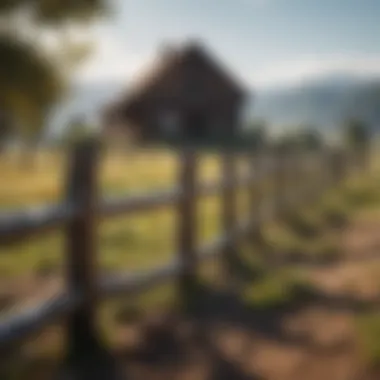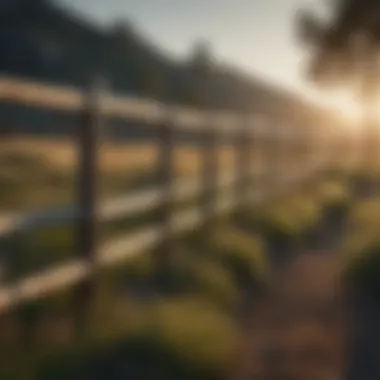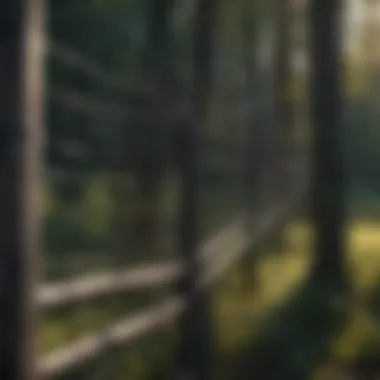Exploring the Western Fence: Purpose and Design


Intro
The exploration of western fences involves understanding their diverse roles within agricultural and pastoral landscapes. These structures have historical, functional, and aesthetic significance that can greatly impact both land management and the visual appeal of rural settings. By delving into various aspects of western fence construction, it becomes evident how these barriers do more than contain livestock or delineate property boundaries; they also influence ecological systems and contribute to the cultural heritage of regions.
In this article, we aim to uncover the multifaceted nature of western fences, taking into account materials, designs, and the practicalities involved in their construction. This investigation appeals to those who appreciate the intersection of functionality and artistry in fence design.
Research Overview
Summary of Key Findings
Western fences serve multiple purposes. They are essential for managing livestock and protecting crops. Additionally, they have evolved in their design and construction, reflecting both historical traditions and modern innovations. Key findings include:
- The choice of materials such as wood, steel, and wire impacts durability and maintenance needs.
- Various designs can affect the movement of wildlife and livestock.
- Ecological considerations are crucial, as some fence types may hinder animal migration or local biodiversity.
- The artistic elements of fencing contribute to the cultural identity of a region.
Importance of the Research in Its Respective Field
Understanding western fences is vital for land management and conservation efforts. This research provides insights that help practitioners make informed decisions about design and materials. It further supports ecological assessments, ensuring that the needs of both agriculture and wildlife are met.
By exploring the implications of fence construction, this study aims to bridge the gap between traditional practices and modern advancements, ultimately enhancing the sustainability and aesthetic value of agricultural landscapes.
Intro to Western Fences
Western fences are more than just physical barriers. They serve a multitude of purposes that reflect both functional needs and aesthetic choices. The purpose of this section is to provide insight into the significance of western fences, examining their evolution and cultural relevance across different landscapes. Understanding these elements is critical for those involved in agriculture, land management, or landscape architecture.
Historical Context and Evolution
The origins of western fences can be traced back to the early settler days. Initially, fences were primarily constructed for practical reasons such as keeping livestock contained and demarcating property lines. The evolution of fencing materials reflects advancements in technology and resources over time. Early fences used natural materials like wood and stone, often sourced directly from the landscape. As communities developed, so did the styles and purposes of fences, transitioning towards more standardized methods and materials.
Different regions witnessed unique adaptations of fence design based on local environmental conditions. For example, the arid environments of the Western United States favored barbed wire, which provided an effective solution against rangeland erosion while requiring less material than wooden fences. This historical context reveals a fascinating interplay between necessity and creativity in fence construction.
Cultural Significance in Western Landscapes
Western fences are emblematic of the cultural identity of many rural communities. They symbolize not only boundaries and ownership but also the values of stewardship, tradition, and resilience inherent in agrarian lifestyles. Fences often serve as markers of personal and community heritage, reflecting the narratives of families and their connection to the land.
In addition, fences can influence the aesthetics of a landscape. When designed thoughtfully, they integrate seamlessly into the natural environment, enhancing its overall appeal. Western fences bear witness to a deep-rooted relationship between people and land, illustrating how structures can embody cultural stories and ecological considerations.
"Fences are not merely functional barriers; they tell stories about the land, the people, and their histories."
Functional Aspects of Western Fences
The functional aspects of western fences are fundamental to understanding their role in agricultural contexts. A fence is not just a boundary marker; it serves multiple purposes crucial for land management, animal control, and maintaining the integrity of property lines. The implementation of western fences involves a careful consideration of these functionalities, as they impact both the efficiency of land usage and the preservation of ecological systems. Examining these aspects provides insights into how fences contribute to a balanced agricultural practice.
Purpose in Land Management and Animal Control
Western fences are primarily constructed to manage land effectively. They help in segmenting areas for specific uses, such as grazing, cultivation, or wildlife preservation. By using fences, ranchers can control the movement of livestock, preventing overgrazing in certain sections. This management ensures that the land remains fertile and productive over the long term.
Moreover, fences can be designed to accommodate different types of animals. For example, barbed wire works effectively for keeping cattle in designated areas, while woven wire may be more suitable for smaller animals. This tailoring of fence types directly influences livestock health and behavior, minimizing stress and accidents that might arise from straying.
"Effective land management relies on appropriate fencing to maintain productivity and ecological balance."
Another critical aspect is water conservation. By utilizing fences to delineate grazing areas near water sources, ranchers can prevent overuse and deterioration of these vital resources. Fencing also helps protect crops from animals that might otherwise consume them, ensuring a stable food supply while supporting wildlife preservation efforts.


Influence on Property Boundaries and Legal Implications
Property boundaries often dictate land use rights, making the role of western fences significant in legal contexts. A well-defined fence line can clarify ownership and reduce disputes between neighbors. Fences contribute to maintaining legal boundaries, as they serve as clear indicators of property limits.
Legal implications can arise when fences are improperly placed. Encroachment issues may lead to legal battles, which can be costly and time-consuming. Therefore, it is essential to follow local regulations while erecting a fence. Understanding property laws and how they relate to fencing decisions ensures that landowners do not inadvertently infringe on adjacent properties.
In addition, property taxes can sometimes be influenced by the use of fences. Fenced areas may be eligible for different taxation rates compared to unfenced land, based on their usage declaration. This aspect should be part of any financial consideration when planning an area.
Materials Used in Construction
The choice of materials in constructing western fences is a fundamental aspect that greatly affects their functionality, durability, and aesthetic appeal. This section will examine traditional materials and techniques alongside modern innovations in fencing materials. Furthermore, we will explore the sustainability considerations that come into play when selecting materials for fencing projects.
Traditional Materials and Techniques
Historically, western fences have been made from readily available materials that reflect both the environment and the needs of land management. Wood has been the primary material for many traditional fences. Types of wood like cedar, redwood, and pine are favored for their natural resistance to decay and ability to withstand various weather conditions. Techniques such as post-and-rail fencing, split rail styles, and stock fencing have evolved from practical needs, often utilizing local timber. Cement and stone have also been used, offering increased stability but requiring more effort for installation.
The utilization of barbed wire came about in the late 19th century, revolutionizing fencing by providing cost-effective and efficiently strong options for keeping livestock contained. This innovation not only enhanced property security but also transformed pastoral management practices. Techniques used in traditional fencing emphasize practicality and enduring materials, illustrating a deep connection between the craft and the environment.
Modern Innovations in Fence Materials
As technology and design have advanced, so too have materials. Today, synthetic options like vinyl, composite, and metal have emerged, presenting unique advantages. Vinyl fencing offers a maintenance-free option with a long lifespan, resisting fading, cracking, and warping. Metal fencing, such as aluminum or galvanized steel, provides strength and durability, often chosen for contemporary styles and minimalistic designs.
Moreover, composite materials combine wood fibers with recycled plastic, offering a sustainable choice that mimics the appearance of traditional wood while reducing environmental impact. Therefore, modern innovations not only enhance the choices available for aesthetics but also improve functionality and longevity.
Sustainability Considerations
Sustainability has become an essential consideration in the selection of fencing materials. Many consumers and land managers recognize the ecological impacts of their choices. Traditional wood fencing can raise concerns about deforestation and habitat disruption. Choosing wood from sustainably managed forests, certified by organizations such as the Forest Stewardship Council, can mitigate these effects.
Synthetic materials, often made from recycled content, can provide an eco-friendly alternative. Additionally, utilizing local materials reduces transportation emissions and supports regional economies. The design of fences should also incorporate wildlife-friendly elements to minimize habitat fragmentation and support biodiversity. Incorporating physical gaps or wildlife corridors can enhance ecological sustainability while maintaining fence function.
"Selecting the right materials involves understanding both the immediate needs and the long-term impacts on the environment."
In summary, the materials used in the construction of western fences are crucial both practically and ecologically. Understanding the evolution from traditional materials to modern innovations, while emphasizing sustainable practices, allows for informed decisions that respect both land management needs and environmental responsibilities.
Design Elements and Trends
Design elements in western fencing play a significant role in both functionality and aesthetics. These elements shape how a fence interacts with the surrounding environment while adhering to practical needs. This section explores the impact of various design choices, highlighting the benefits and considerations that influence the use and effectiveness of western fences.
Aesthetic Considerations and Landscape Integration
When it comes to aesthetics, the visual appeal of a fence extends beyond mere materials. A well-designed fence complements the surrounding landscape and enhances the overall ambiance of an area. This integration involves considering color, texture, and form. For instance, using natural wood can evoke a rustic feel, harmonizing with the natural environment. Alternatively, metal fences may offer a modern contrast, appealing to contemporary tastes.
Moreover, landscapers often emphasize the importance of proportion. A fence that is too tall may dominate the landscape, while one that is too short may fail to provide adequate privacy. Additionally, focus must be on the alignment of the fence with paths and structures. Proper positioning can create a visually pleasing flow in the design.
One of the crucial aspects of aesthetic design is functionality. A fence can serve as a living structure; incorporating plants can enhance its beauty and provide shade. This ecological aspect not only enhances visual appeal but also contributes to local biodiversity.
"Design choices must balance functionality with aesthetic appeal to achieve a harmonious landscape that serves both purpose and beauty."
Functional vs. Decorative Design
The tension between functional and decorative design is a central theme in fencing. Functional design prioritizes the primary roles of containment and security. The choice of materials and structure focuses on durability and resistance to environmental factors. Meanwhile, decorative design shifts the focus, emphasizing visual charm possibly at the cost of some functionality.
For effective fencing, it is vital to strike a balance between these two aspects. A decorative fence must still meet safety requirements such as preventing livestock escape or deterring trespassers. Many designs incorporate decorative elements into robust structures to achieve this balance.


Here are several considerations to keep in mind:
- Material selection: Wooden fences can be both functional and beautiful, though they may wear faster than metal options.
- Height: Taller fences can deter intruders while also creating a sense of enclosure, but may obstruct views.
- Design shapes: Curved or geometric designs can add flair while remaining structurally sound.
- Color schemes: Natural stains or paints should blend with nature for traditional aesthetics, whereas bright colors might add a modern touch.
Ultimately, the most successful western fences integrate both functional and decorative elements to create a lasting impression while maintaining their core purposes.
Construction Techniques and Best Practices
The construction techniques of western fencing serve as the backbone to its functionality and aesthetic. Building a western fence requires a clear understanding of proper methods and best practices. These elements not only influence the structural integrity but also the longevity and effectiveness in controlling livestock or marking property lines. A well-constructed fence minimizes maintenance needs and ensures that it holds up against weather and environmental challenges. Effective construction techniques also enhance the visual appeal of the landscape. Moreover, understanding these practices can contribute to sustainability and ecological considerations.
Step-by-Step Construction Process
Establishing a solid step-by-step process for building a western fence is crucial for achieving optimal results. Here’s a simple guide:
- Planning and Design: Start with a clear design that considers the purpose of the fence and the landscape. Measure the area accurately to determine the amount of material needed.
- Gathering Materials: Collect the appropriate materials. Commonly used items include wooden posts, wire, nails, and gravel. Ensure that all elements fit the intended durability and function of the fence.
- Setting the Posts: Dig holes for the posts. The depth may vary, but a typical guideline is to bury one-third of the post's length. Place the posts in the holes and align them vertically. Use gravel to secure the posts.
- Attaching the Rails: After the posts are set and the concrete (if used) has cured, attach the horizontal rails to the posts. It is vital to ensure that they are level.
- Installing the Wire: If the design includes wire fencing, carefully stretch and attach it to the rails. Ensure it is taut to prevent sagging.
- Final Checks: Inspect the entire structure to ensure everything is secure. Make adjustments as necessary. Ensure the design meets legal regulations concerning fence height and type.
Following these steps will create a solid foundation for a well-built western fence.
Maintenance and Durability Considerations
Maintaining a western fence is essential for ensuring its longevity. Different factors can affect a fence's durability, including weather conditions, the materials used, and soil quality.
Some key considerations are:
- Regular Inspections: Routine checks for damage, whether from weather or pests, are crucial. Look for signs like rotting wood, rusting metal, or loose wires.
- Timely Repairs: Addressing issues as they arise prevents larger problems in the future. Replace any damaged or worn components promptly.
- Protective Treatments: Apply weatherproofing treatments to wooden elements, such as sealants or stains. This increases resistance to moisture and pests.
- Soil Quality Management: Water drainage is essential. Poor drainage can lead to post rot. Ensure that the area around the posts allows for effective water runoff.
Following these maintenance tips extends the life of a western fence, making it both cost-effective and functional.
"A well-maintained fence not only protects property but also enhances the overall aesthetic of the landscape." - Unknown
By implementing these construction techniques and maintenance practices, individuals can ensure their western fences serve their intended purpose while standing the test of time.
Ecological Implications of Fencing
Fencing plays a significant role in ecological systems. Understanding its implications goes beyond the mere purpose of delineating property lines or managing livestock. The ecological effects of fences can be both positive and negative, influencing wildlife movement, behavior, and habitat integrity. In this discussion, we shall explore how fencing interacts with natural ecosystems, and the considerations necessary for responsible fencing practices.
Impact on Wildlife Movement and Behavior
Fences can act as barriers for wildlife, impeding their movement across landscapes. Many species have migratory patterns crucial for their survival, whether for feeding, mating, or seasonal migration. When fences disrupt these paths, the consequences can be dire. Animals such as deer, elk, and other large mammals may find their usual routes blocked, leading to increased mortality rates due to vehicle collisions or starvation.
On the other hand, strategically placed fences can create ecological corridors. These corridors facilitate safe passage for various species, enabling them to traverse fragmented habitats. For example, post-and-rail fences allow small mammals and ground-nesting birds to cross pathways safely. Additionally, wildlife-friendly fencing designs can mitigate human-wildlife conflicts. Effective fence design should take into consideration the mobility of species in the area to promote coexistence rather than exclusion.
Fencing and Habitat Fragmentation
Habitat fragmentation is a critical concern in ecological discussions. Fences inherently divide landscapes, potentially isolating ecosystems. Such fragmentation often leads to a decline in biodiversity. Isolated populations face challenges including inbreeding, reduced genetic diversity, and difficulties accessing resources.
Moreover, as habitat becomes increasingly fragmented, some species may be unable to adapt. For instance, certain reptiles and amphibians depend on specific land features for their breeding cycles. If fencing disrupts their habitat without providing suitable alternatives, it can have detrimental effects on their populations.
"The potential for habitat alteration informs how we approach fencing strategies."
In contrast, thoughtful fencing can help maintain habitat integrity when aligned with conservation goals. Fencing that adapts to the natural contours of the land helps preserve important ecological features. It's crucial for landowners and managers to weigh the costs of habitat loss against their fencing goals. This understanding can lead to more sustainable practices that benefit both land use objectives and ecological welfare.


Case Studies and Real-World Applications
Case studies are invaluable in providing practical examples of how theories and methods surrounding western fences find real-world application. They illuminate both the successes and failures experienced in various projects, allowing practitioners and researchers to gain insight that extends beyond textbook knowledge. Understanding these case studies enhances the practical knowledge of fence implementation, helping to adapt and refine practices based on empirical evidence.
Successful Implementations of Western Fences
Many farming operations have successfully integrated western fences into their land management strategies. For example, the ranching community in New Mexico has utilized corral fences made of cedar and barbed wire to efficiently manage livestock. These configurations not only protect the animals but also maintain specific grazing patterns that benefit both the land and the livestock.
- Increased Efficiency: Fences help in managing animal movement, ensuring they access fresh pastures regularly.
- Protection from Predators: Strong, well-constructed fences offer a physical barrier, keeping livestock safe from predators, which is a critical concern in many rural areas.
- Cost-Effectiveness: Employing local materials reduces costs significantly. Some ranchers have used reclaimed wood, which is not only economically sensible but also environmentally friendly.
These examples underscore that a properly designed and constructed fence can optimize land use while addressing animal welfare effectively.
Lessons Learned from Failed Projects
Conversely, there are instances where the fencing projects did not yield positive outcomes. One notable case involves a project in southeastern California aimed at restricting wildlife movement to protect fragile ecosystems from livestock grazing. The specific fence design employed was too high and solid, which inadvertently restricted access for native species.
- Wildlife Resistance: Certain species, such as deer, struggled to find routes across the fence, leading to unintended consequences in local biodiversity.
- High Maintenance Costs: The design chosen required more upkeep than anticipated, creating financial strain on the operation.
- Community Backlash: The negative impact on wildlife sparked community opposition, showing the importance of community engagement in planning.
These failures highlight essential considerations in the design process. Notably, understanding local biodiversity and engaging with the community before implementation can make a significant difference. Therefore, incorporating feedback and adjusting designs early can lead to both successful projects and better ecological outcomes.
Future of Western Fencing
The future of western fencing is a topic that warrants critical attention. This discussion is essential as it highlights evolving practices that impact land use and community engagement. Understanding the future of western fencing allows landowners, ecologists, and policymakers to adapt to changing environmental and social landscapes. The implications of improper fencing can be profound, leading to issues such as wildlife disruption, legal disputes, and decreased land utility. Incorporating contemporary approaches will offer solutions that harmonize fencing with ecological best practices.
Emerging Trends and Technologies
Emerging trends in western fencing are characterized by sustainability and efficiency. The integration of technology into fencing is making it possible to create more adaptive solutions. For instance, smart fencing systems, which include sensors and automated controls, enable real-time monitoring of fence conditions and animal movements. This use of technology increases the utility of fencing, creating benefits like reducing labor costs. Here are some notable trends:
- Biodegradable Materials: Innovations in materials are making fences less of a burden on the environment. Using materials that decompose over time helps mitigate ecological impacts.
- Solar-Powered Electric Fences: These systems are becoming more prevalent. They offer a renewable energy source, making them ideal for remote areas.
- Modular Fence Designs: Advancements allow for more flexible designs, accommodating different terrains and purposes with ease.
These innovations indicate a shift towards fences that are not only functional but also considerate of their ecological footprint.
The Role of Community in Fencing Design
Community involvement in the design and implementation of western fencing is increasingly recognized as vital. Local stakeholders bring invaluable insights into the specific needs of their environment. By engaging with community members, fencing becomes a reflection of collective values. Considerations include:
- Local Wildlife Needs: Community input can guide the design of fences that minimize threats to wildlife movements. This is crucial for maintaining native species health.
- Cultural Heritage: Understanding local history and cultural significance helps preserve identity. Appropriate fencing styles can respect this heritage.
- Economic Factors: Collaboration can lead to cost-sharing initiatives for maintenance, ensuring longevity and sustainability of fencing projects.
Promoting communal participation forms a cohesive approach that strengthens local governance and resource management.
"Effective fencing is not just about property lines but about fostering cooperation with nature and the community."
This future-focused approach highlights the importance of adaptability in western fencing, ensuring it serves both landowners and the environment.
The End
The conclusion of this article serves as a crucial synthesis of the multifaceted role that western fences play in both agricultural and ecological systems. The importance of this topic stretches beyond mere utility; it encapsulates the underlying principles of land management, property definition, and community interaction. Recognizing how these structures interweave with the landscape helps in appreciating their cultural and historical significance.
Recap of Key Points
- Historical Context: The evolution of western fences reflects broader changes in land use and governance. Understanding this history adds depth to the modern applications of fencing.
- Functional Aspects: Fences serve several purposes. They are not just barriers; they define property lines, manage livestock, and assist in land use planning.
- Materials and Innovations: From traditional wooden fences to modern composite materials, the choices in construction reveal much about technological advancements and sustainability concerns.
- Design Elements: Both aesthetic and practical considerations shape the design of fences. The balance between decorative and functional aspects is vital in creating spaces that are both usable and visually pleasing.
- Ecological Impact: The implications of fencing on wildlife and habitats must be taken into account, showing the significant interaction between agricultural practices and environmental preservation.
Final Thoughts on Western Fences
In wrapping up this exploration, it is evident that western fences are pivotal structures in the landscape, representing an intersection of culture, utility, and environmental stewardship. The ongoing dialogue about their design and use reflects broader societal priorities. As trends continue to shift towards ecological mindfulness and sustainable practices, embracing these values in fencing design will only become more essential.
"The design and function of fences will evolve, but their role in delineating and shaping our landscapes remains timeless."
Ultimately, for students, researchers, and practitioners, understanding the complexity of western fences equips them to contribute thoughtfully to discussions surrounding land use, design, and sustainability in an ever-changing environment.







